Creativity has no limits, but there are those who feel empowered to impose them. False interpretations, and probably conditioned by the dictates of each era, have, for example, banned paintings, sculptures and performances that today are considered masterpieces. The ban on the following works shows that sometimes, when censorship is intense, the public suspects ... that these works are really worth it.
Creativity has no limits, but there are those who feel empowered to impose them. False interpretations, and probably conditioned by the dictates of each era, have, for example, banned paintings, sculptures and performances that today are considered masterpieces. The ban on the following works shows that sometimes, when censorship is intense, the public suspects ... that these works are really worth it.
There is that meme-like phrase that says "the earth without art is just eh". A truth that for some seems absolute, for others debatable: throughout the years - and even in modern times -, there are those who cite creative differences when it comes to considering some works as artistic. "Blasphemy", "shocking", "pornographic" were used where, sometimes (other times, not really), it should read "wonderful", "brilliant", "work of art". Controversial is an understatement for pieces that for years have been (or still are) hidden, cursed, forbidden. But history made sure that infamy was also a part of its unavoidable fame, and some you probably don't even suspect that they were once misunderstood and labeled shocking.
Like the one you see here: The Judgement Day (1535-1541), by Renaissance painter Michelangelo, is a fresco on the wall of the altar in the Sistine Chapel and represents the Last Judgment in the biblical narrative, more specifically the second coming of Christ and God's final judgment on all mankind. The painter worked on this 25 years after completing the Chapel's ceiling. Little did he know the hype it would generate: his interpretation was immediately disapproved by the Catholic Church, which rebelled against the painting for a number of reasons, such as the fact that the artist represented Jesus without a beard and in the style of pagan mythology, but also because - the horror! - the painting had about 300 individuals along the screen, most of them men, most of them naked. How could there be so much nudity on sacred ground? It most certainly could not. That is why, as a consequence, some pieces of fabric and vegetation were painted on the offending genitalia (and, centuries later, removed, as part of a recovery, in the 20th century). And we thought the free the nipple issue was something of a 21st century peeve... The following pages, with other pieces equally controversial, show that too often, the problem comes from way before.
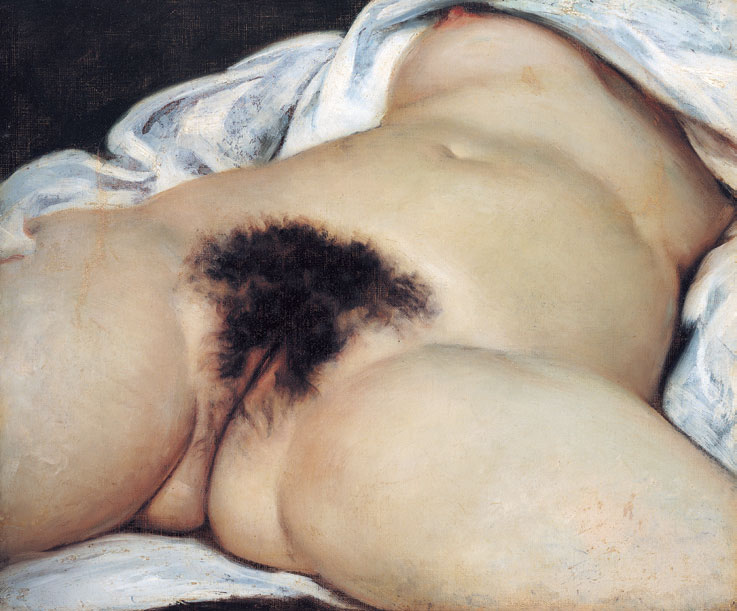
The origin of the World, Gustave Courbet, 1866
Just taking a glance at The Origin of the World (1866), by Gustave Courbet, and we can immediately imagine the warning written in quill on a paper scroll: “Your painting has been removed because it violates the community laws.” If we find it strange that it could happen in 2021, it seems more obvious why it happened in the 19th century. At a time (only allegedly) more prude than the one we live in, the painting is voluntarily provocative, showing a close-up of a woman's vagina and womb, in a close-up that could be considered pornographic - even by today's standards. In fact, it is: the French police banned a novel that used a reproduction of the painting as a cover and, in 2011, Facebook censored the work, removing or blocking accounts that shared the painting's image. But its purpose was not pornographic, just the reproduction of "the origin of the world", in a painting considered to be faithful to Realism.
Les Demoiselles d’Avignon, Pablo Picasso, 1907
The man we see in this image is Pablo Picasso and, in the background, is a work that is both iconic and controversial. And it actually would be like this, as a backdrop and not under the spotlight, that many preferred to see Les Demoiselles d'Avignon (1907), a cubist piece, by the Spanish painter, that illustrates five prostitutes and, in the title, also refers to a street in Barcelona famous for its brothel. The painting was poorly received, even by the artist's friends, not only for its protagonists and nudity, but also for their style, and for the way he illustrated them in an angular, geometric and deformed way. People are so square.
Fountain, Marcel Duchamp, 1917
When your 'toilet' is refused by a “club” that accepts virtually anyone, you cannot help but think that your career has gone downhill. But not in the case of Marcel Duchamp: Fountain (1917), the porcelain urinal that he submitted, anonymously (signed simply as “R. Mutt 1917”), as a finished sculpture, to the consideration of the Society of Independent Artists, known for saying yes to everything as long as the fee was paid - and of which Duchamp was a co-founder and member of the board - ended up being refused by said society. Well, in fact, it was accepted (after all, all works were, in fact, welcome, upon registration fee), but it was never exhibited. There were those who thought it was simply a prank; there were also those - the Dadaist newspaper The Blind Man, for example -, on the contrary, labeled the work as art because the artist had understood it that way. Its impact was much greater than its refusal and controversy: it triggered a dialogue still running today about what, in fact, consists a work of art. In fact, in December 2004, it was considered the most influential artwork of the 20th century by 500 experts in the field (ahead of Les Demoiselles d’Avignon, by Picasso, and Marilyn Diptych, by Warhol).
The Guitar Lesson, Balthus, 1934
A woman "playing guitar" on a girl is what looks like - or illustrates - The Guitar Lesson (1934), by Balthus. The guitar itself is inanimate on the floor, while this music teacher grabs the hair of her young student and touches the girl, lying on her lap, half-naked. The woman's hand as if she were playing the strings of a guitar falls dangerously close to the child's vagina, in a picture that alludes to pedophilia. The work was so contested when it was exhibited, as part of the artist's first show, in Paris, that it ended up hopping from museum to museum without ever having been exhibited, from 1977 until today. No one has ever dared to do so - and one can see why. But many continue to tell its story, something that woudl displease Balthus, who always maintained that his works were to be seen and not the object of analysis. In fact, when Tate looked back at his work and asked him for a biographical note, this was his response: “No biographical details. Start: Balthus is a painter about whom nothing is known. Let us see, then, the paintings. Regards. B."
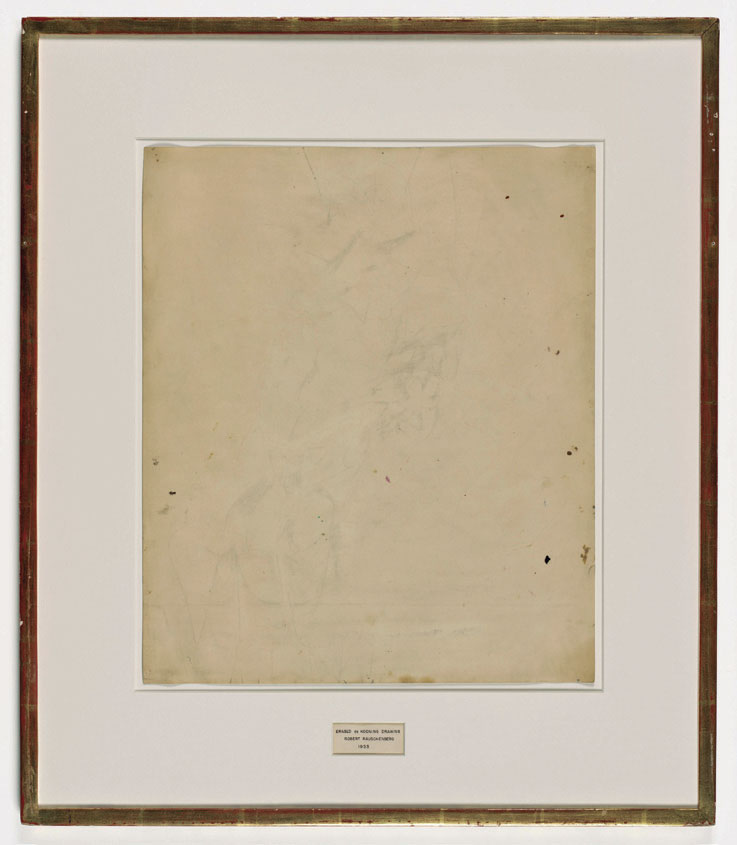
Erased de Kooning Drawing, Robert Rauschenberg, 1953
You know that episode of Banksy and his painting that was destroyed right after it was auctioned off? This story is just as funny. For Robert Rauschenberg, his Erased de Kooning Drawing (1953) was a brilliant work of art, although completely erased. The artist was only 27 years old when he arrived at the door of abstractionist Willem de Kooning (at the time, at the height of his career), with a bottle of Jack Daniel's in his hand - perhaps for that dose of liquid courage - and asked him to yield one of his drawings (business as usual, contemporary artists used to exchange works and the two had already met at college). The strangeness of the request followed: he wanted to erase it. A bold request, since, at the time, there were Kooning paintings sold for ten thousand dollars, for example. But the purpose was exactly that - it didn't make sense to go ahead with the concept of eliminating the trace of an artwork if it belonged to someone who was not consensual to the public as a creative person. "If it was my own work to be erased, that would only be half the process, and I wanted it to be the process in itself," explained Rauschenberg. De Kooning was skeptical, but when he agreed, he handpicked the illustration: “It has to be something I'm going to miss,” he said to the young artist. The illustration provided was done in pencil, ink, charcoal and graphite, and took two months to be erased. When he finally framed it, in 1955, to exhibit it, he did not receive criticism, but everyone spoke of that blank sheet smeared within the “alleys” of the artistic milieu and put on the table the question of whether the “non-image” was also an art image. Today, it is considered to be Rauschenberg's most controversial work, although it was not particularly scandalous, like others.
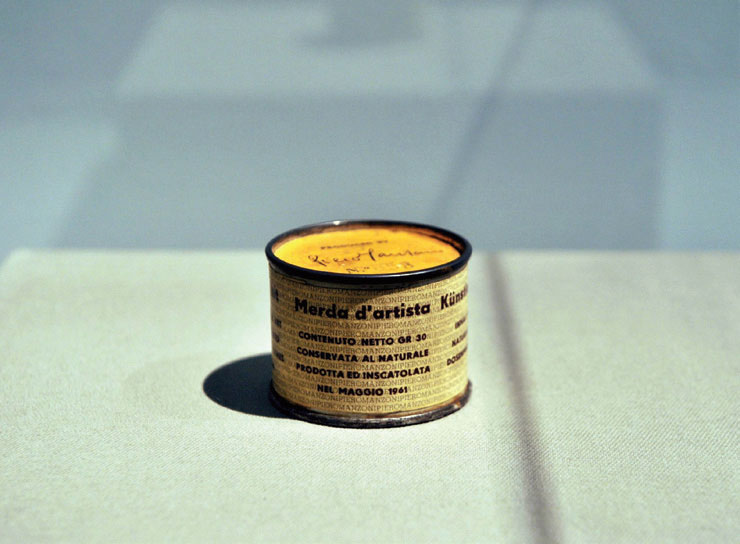
Merda d’Artista, Piero Manzoni, 1961
Merda d’Artista (1961) by Piero Manzoni could not be more explicit in its title. We don't know if it was the egg or the chicken that came first, but we know that it was the toilet (by Duchamp) and only after the excrement, by Manzoni. The Italian avant-garde creative placed 2,700 grams of his feces in 90 metal cans as a response (it is said) to a derogatory comment from his father, owner of a canning factory, about Piero's work, comparing it to… well, there is no better word: poop. Di he exceed the limits (of decorum, public health, sanity)? Those who paid 275,000 euros at an auction for one of these “shit canned goods” would argue he didn't.
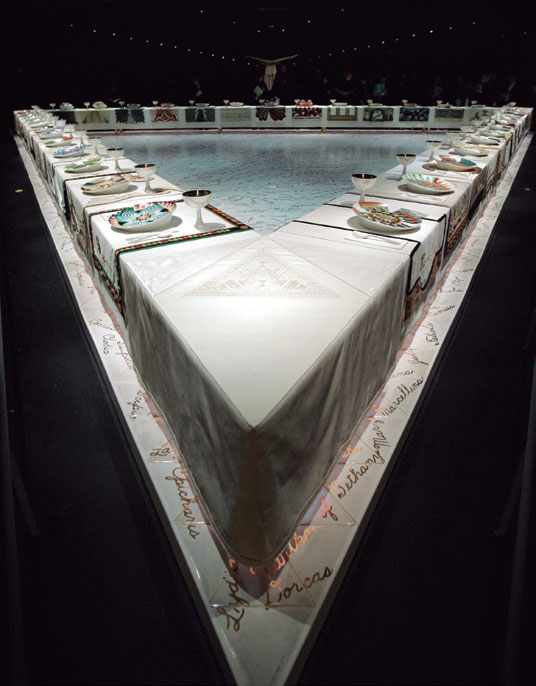
Dinner Party, Judy Chicago, 1979
On tonight's menu: vulvas. This is what American Judy Chicago seems to have thought when she imagined this Dinner Party (1979). Its triangle-shaped banquet, commemorating the female contribution, from Sappho to Virginia Woolf and Georgia O'Keefe, to world cultural history, had 39 seats (for a list of 39 iconic women), arranged with hand-painted dishes where you could see vulvas in bloom. Some applauded the audacity - feminist critic Lucy Lippard reported her experience as being strongly emotional, underlining how she became more and more addicted to its details and subliminal messages; others accused the vulgarity of it - like British artist Cornelia Parker, who told The Guardian that the installation was more about elevating Chicago's ego than celebrating the honored women. "We are all reduced to vaginas, which is kind of depressing," she concluded. Art critic Hilton Kramer corroborated it, comparing it to an ad campaign, so narrow-minded. The artist Maria Manhattan even satirized the installation with The Box Lunch (1980), in an art gallery in Soho, describing it as a “great art event honoring 39 women of dubious distinction.” Despite this, the piece remains on display at the Brooklyn Museum and is regarded as a milestone in feminist art.

Rhythm 0, Marina Abramovich, 1974
In 1964, Yoko Ono organized a provocative artistic performance in which she invited the public to take a pair of scissors and cut a piece of her clothes while she remained motionless and silent. People were so shocked that they didn't even talk about it, Ono confessed, later on, about her Cut Piece. A decade later, Marina Abramovich took the concept to heart imagining Rhythm 0 (1974), but raised the bar to a more evil and perverse level. The artist made 72 objects available to the public (in addition to the scissors, she had a whip, a feather, a rose, a scalpel, a gun, a candy, a slice of chocolate ...) that the participants could choose and do as they pleased with it. The performance lasted six hours and, over time, the audience escalated the degree of violence: Abramovich assumes that she still has the scar on her neck from which one of the participants drew blood and recalls that "she was prepared to die" when one of the participants pointed a gun at her head, triggering a fight inside the gallery, about the limits having been crossed. When she reached the end, Marina says that everyone avoided looking her in the eye.
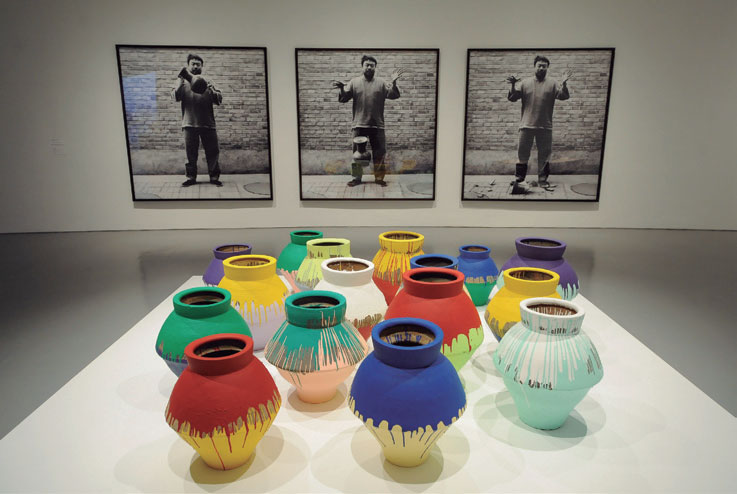
Dropping a Han Dynasty Urn, Ai Weiwei, 1995
They are just ceramic pots. Except they're not. They are a sort of Duchamp's Fountain, but a 90's version: Ai Weiwei winked at Marcel with Dropping to Han Dynasty Urn (1995), where he dropped, and consequently destroyed, ceremonial urns over two thousand years old. The controversy didn't take long to show itself, not only for the real value of the urns (Weiwei is said to have paid hundreds of thousands of dollars for the items) but also because they are symbols of Chinese history, leading many to consider the performance as devoided of ethic. "The only way to build a new world is to destroy the old," replied Ai, quoting words from Mao Zedong. And breaking vessels, i mean, rules, i mean, limits.
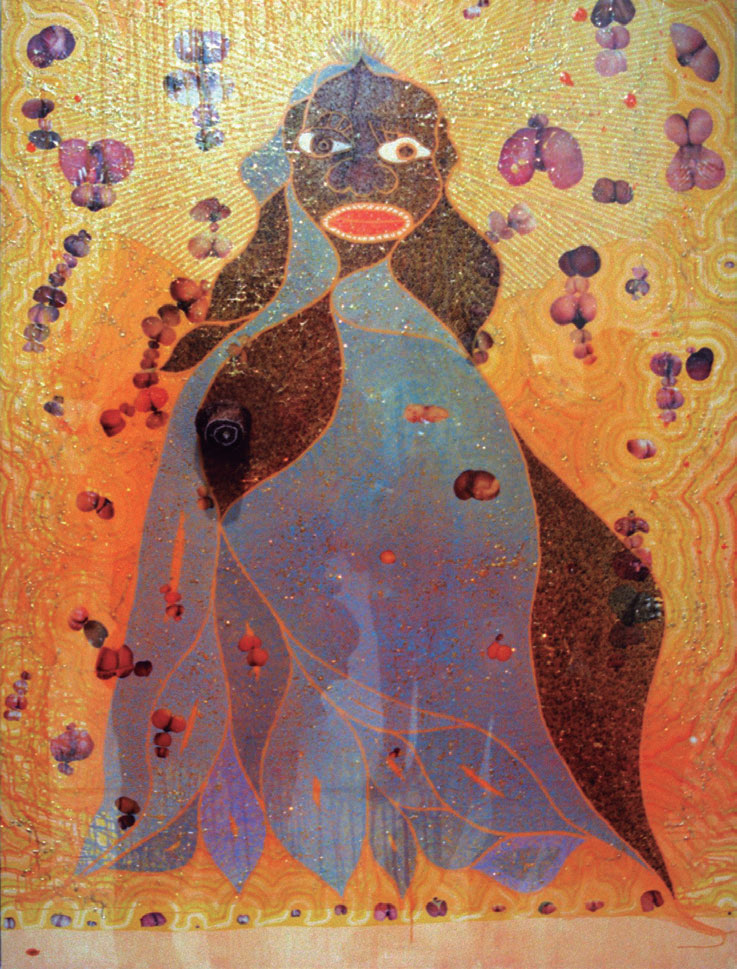
The Holy Virgin Mary, Chris Ofili, 1996
Sensation was the name given to the exhibition that opened in London in 1997, with a number of artists whose selection of their body of work was really, as the title says, to move you. And everyone knows that when emotions are running high, the tendency to controversy is huge. It was only when the show arrived in New York, in 1999, that The Holy Virgin Mary (1996), by Chris Ofili, was widely repudiated: the collage of the Virgin includes resin, oil paint, polyester, map pins and… ah, yes, clippings from pornographic magazines and elephant droppings. Protests from religious leaders, celebrities and even mayor Rudy Giuliani, who threatened to remove the $7 million grant from the exhibition, were not enough to ban it forever and Ofili's Madonna is now in the permanent collection of the MoMA.
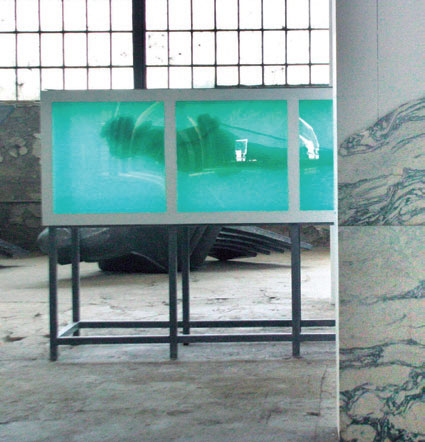
Shark, David Cerny, 2005
Following Damien Hirst's bold installation, The Physical Impossibility of Death in the Mind of Someone Living (1991) - where a shark suspended itself in a solution of formaldehyde -, Czech artist David Cerny placed a faithful sculpture of the deposed Iraqi dictator Saddam Hussein in a glass box, tied up like a piglet and suspended in this watery formula. The comments on Shark (2005) were divided between those who thought that the installation put Hussein almost in the role of a victim and those who thought that the work was too graphic and gratuitous. In the end, his show scheduled for Belgium in 2006 ended up being canceled, fearing that some sections of the population would find it too provocative.
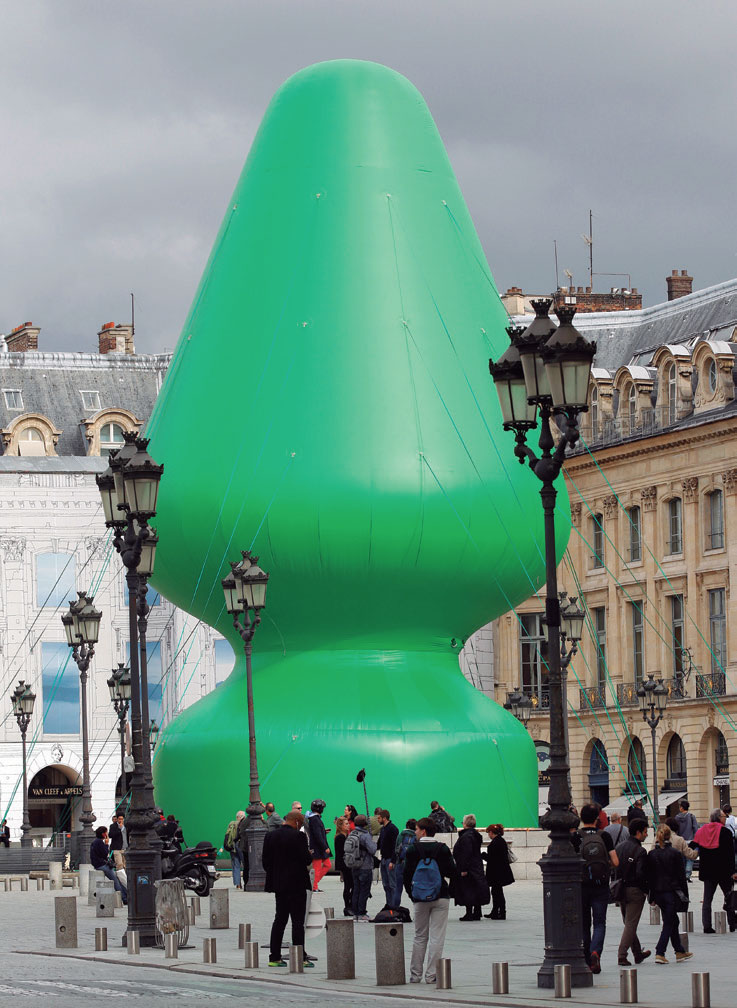
Tree, Paul McCarthy, 2014
What do you see in this image? That's correct: a Christmas tree. It was with this idea in mind that, in October 2014, the American artist Paul McCarthy, placed this butt plug, pardon, inflated pine tree, in the middle of Place Vendôme, in Paris, overlooking the Ritz and the most prestigious jewelers of the area. The reception of this Tree (2014) was incredible, as you can imagine: there was no bling bling brand representative who did not want to give up one of his ornaments to place on this butt plug, sorry, giant Christmas symbol. Quite the opposite, of course: the “tree” was repeatedly vandalized and the artist himself was slapped in the face three times by a deeply offended passerby.
Domestikator, Joep van Lieshout, 2015
Domestikator (2015), by Dutch artist Joep van Lieshout, a massive sculpture that appears to represent a man having sex with a four-legged animal, was supposed to be presented at the Louvre, Paris, in 2017, but the museum refused it saying it to be too much explicit to be exhibited there. We do not know whether the glass roofs of the space are only literal or whether they would also be metaphorical, but mirrored Center Pompidou, which is no stranger to controversy - its metallic structure did not please lovers of classical Parisian aesthetics when it was built - did not refrain from receiving the work. Van Lieshout explained that the purpose of the controversial piece was to represent the domestication process and to start the conversation about the tendency of humans to subjugate nature.
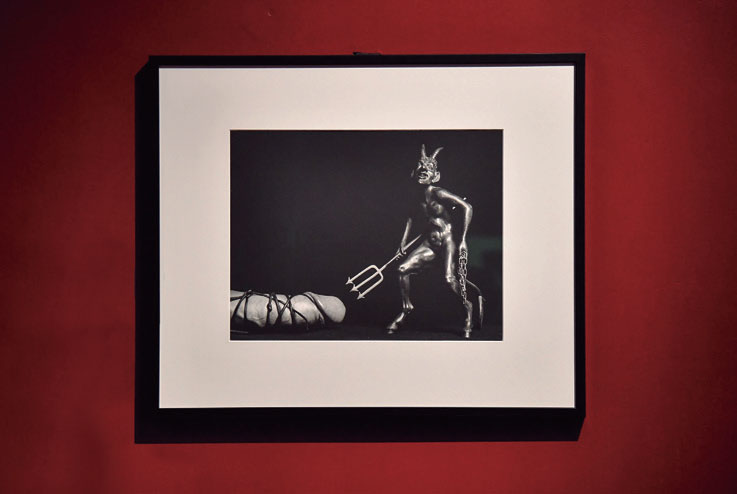
Robert Mapplethorpe: Pictures, 2018
It was in 2018 that art “shocked” Portugal, courtesy of photographer Robert Mapplethorpe. The artist's retrospective, in Serralves, was challenged even before its opening, due to the graphic nature of his body of work, which ended up being censored in that Museum. On opening date, September 20 of that year, Robert Mapplethorpe: Pictures debuts with 20 banned works and, therefore, removed from the show; access to minors under 18 conditioned by the company of an adult and two rooms admitting adults only; the cherry on top of the cake comes 24 hours later, with the resignation of the artistic director of the Serralves Museum of Contemporary Art, João Ribas, confessing that he was unable to continue running the institution in Porto. Fortunately for art - and artistic nudity - Google doesn't have that kind of filter.
Translated from the original on Vogue Portugal's The Forbidden issue, published april 2021.Full credits on the print issue.
Most popular

O que lhe reservam os astros para a semana de 30 de dezembro a 5 de janeiro
30 Dec 2025
.jpg)
.jpg)
Relacionados

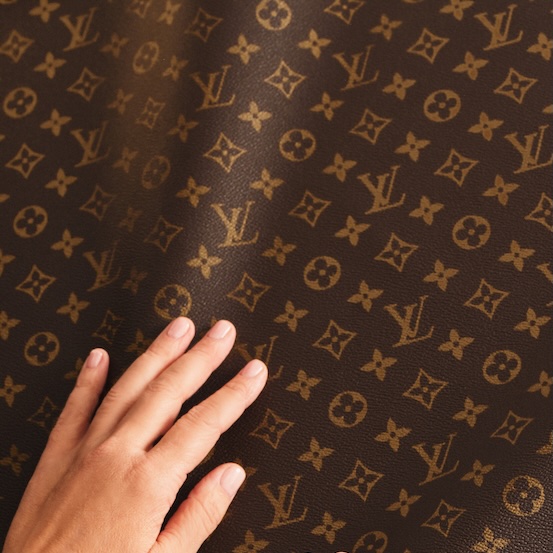
Louis Vuitton: aniversário do icónico Monogram celebra-se com muitas novidades
01 Jan 2026



.jpg)